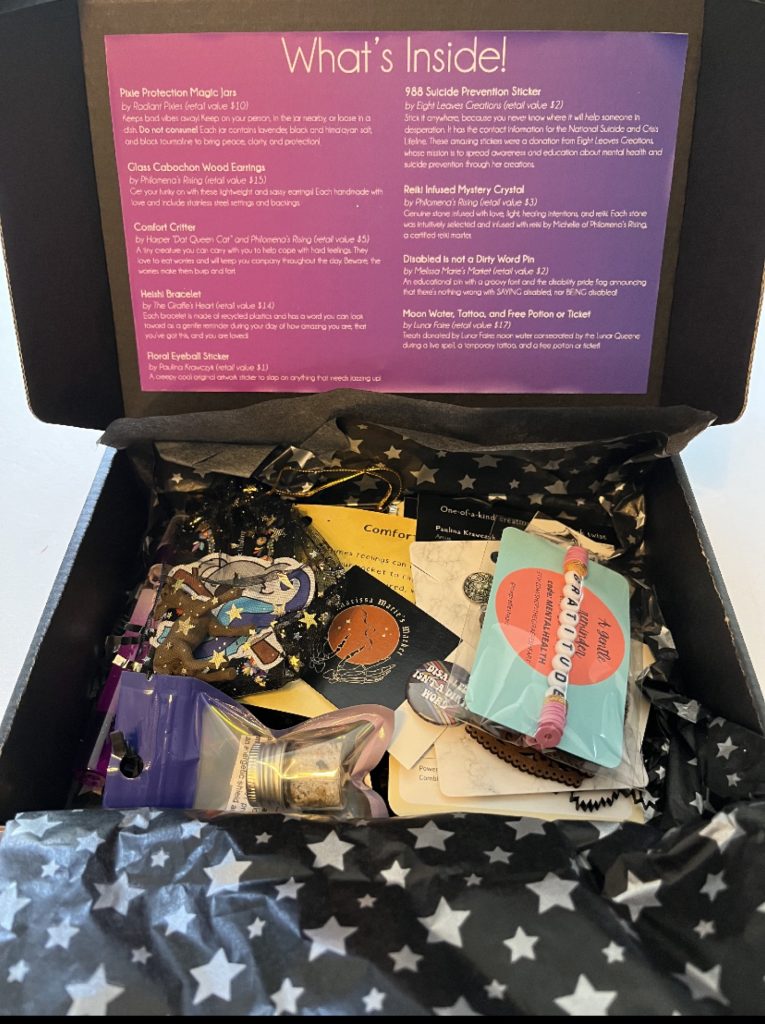WOODBINE – While Michelle Walsh, of Woodbine, was recovering from brain and neck surgery, she started making jewelry, symbolically rebuilding what was broken in her life. The art therapy was just the beginning of her three-year journey to find out what was causing the joint and muscle pain, headaches, joint hypermobility, gastrointestinal problems, and other issues.
She persevered, however, and recently was diagnosed with Ehlers-Danlos syndrome (EDS), a group of 13 heritable connective tissue syndromes affecting fewer than 200,000 people in the U.S. annually, according to the Mayo Clinic.
“Trust your body and what you are feeling,” the mother of two advised. “You need to advocate for yourself. Just because you have a chronic illness does not make you invisible. Document your symptoms so you can show your doctor what you are feeling. Eventually, you will get to the right doctor and diagnosis.”
Today, Walsh’s jewelry-making has become a small business, and she has joined with other artists to build a Disabled Artist’s Box, holding items meant to comfort, bring awareness to various disorders, and help the artists make a living.
“Having the right support system is so important to help with your healing,” Walsh added.
She recounted how, after her brain surgery, she couldn’t walk. Her husband brought her two children to the hospital to see their mother, and Walsh was motivated to start walking again.
“My children were young when I went through surgery, but I tried to prepare them as best as we could,” she said. “They know I am disabled, and there are days I am not feeling so good. They know when to give me a hug. I am very fortunate to have friends and family for support, and I am able to teach my children about kindness and compassion.”
Besides friends and her family, Walsh, 40, finds support at the Lunar Faire, a night market in Fairfield where she started a community resource booth to share mental health and other community resources, inspiration, and motivation.
In addition, she worked with the EDS Society to have Gov. Phil Murphy designate May as EDS and Hypermobility Spectrum Disorders Month to bring awareness to the syndromes and encourage early diagnosis and support groups.
“There are so many people with chronic illnesses,” Walsh pointed out. “There is no age when someone can be affected. People need to be compassionate and supportive. Chronic illnesses, like EDS, affect young and old, males and females. By making people more aware, they may be willing to help donate to help research and develop more structured treatment.”
Walsh, who was a trauma therapist for the U.S. Department of Veterans Affairs, first suffered from severe pain in her neck, which led to a diagnosis of Chiari malformation, where her brain was too large for her skull and her brain stem was compressing her spinal cord. She had a craniotomy, and her C-1 disc was removed from her neck.
Recovery was tough, as her muscle and joint pain worsened, along with headaches and gastrointestinal issues.
“I went back and forth to so many doctors, getting diagnoses covering everything from Parkinson’s disease to multiple sclerosis,” she recalled. “Because I was in so much pain, I was taking a lot of medication, and doctors thought the pain was from the meds. People with EDS have a lot of sensitivities. My hands and feet were different colors. I was so tired of seeing doctors, I just wanted to live my life. Finally, a doctor in Vineland recognized all the symptoms as EDS with dysautonomia/Postural Orthostatic Tachycardia Syndrome (POTS) condition, which affects my heart.”
“When I look back over my life, I see many signs of EDS,” she added, “but I had Lyme disease when I was younger, and I had problems with my fine motor skills, as well, so the doctors thought my problems were connected with that. EDS is a progressive disease, so you are developing symptoms as you age.”
As an example, Walsh said she uses a cane since having brain surgery, but now must use a walker for long distance. Because one of the EDS symptoms is an imbalance of collagen, causing “elastic skin” that bruises easily, she looks much younger than her 40 years.
Walsh believes her mother also has EDS, but, so far, neither of her children have presented any symptoms. Neither have her two brothers.
“I get tired easily, so I understand that I have so much energy available,” she noted, “so I give it to my family and friends.”
“I’m fortunate to have such a great support system. They have helped so much with my healing,” she added.
Contact the author, Karen Knight, at kknight@cmcherald.com.








